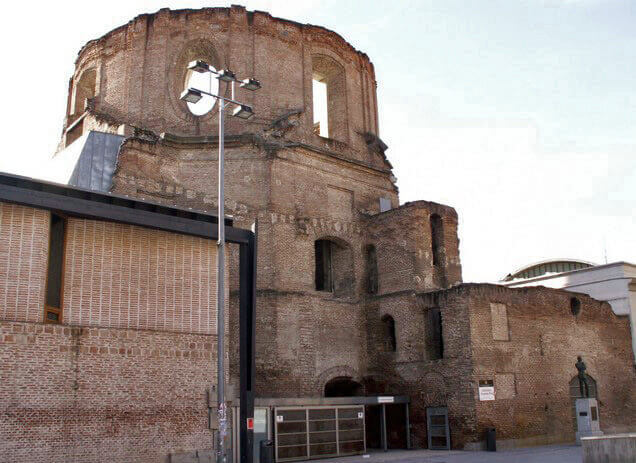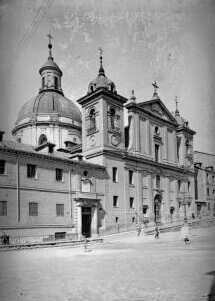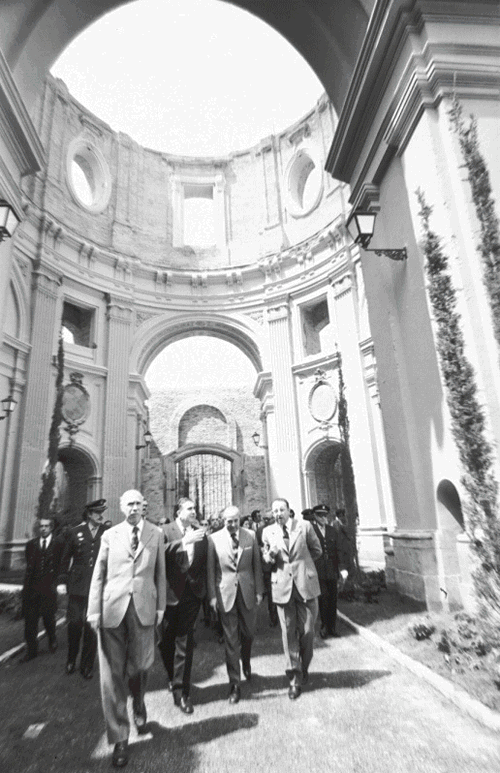The Cultural Center of the Piarists- Recovered Ruins

The intervention to create the Cultural Center of the Piarists in the Lavapiés neighborhood in Madrid and the surrounding area is a wonderful example of rehabilitating ruins. The project encompassed various scopes that range from urban surroundings to interior design.
We can also identify different construction systems in the project, all of which work with the original structure in diverse ways. The architects carefully integrated new materials while maintaining a balance throughout the entire work.
The intervention aimed to connect all of the spaces, creating a unified cultural center.
The Cultural Center of the Piarists – intervention project

The intervention project took place between 1996 and 2004. Today, the Online Learning Center Escuelas Pías uses the rehabilitated ruins. It was a one-of-a-kind intervention that can hardly be pigeonholed into a single category.
The project encompassed restoration, rehabilitation, and new construction. However, although diverse components that made up the project, the cultural center is perfectly balanced. All of the elements work together with each other to create a beautiful display of both past and present.
Spanish architect José Ignacio Linazasoro lead the massive project. The fruit of his work is an incredible cultural center lifted from the church ruins of the ancient Piarist School of San Fernando.
The intervention involved urban planning as well and reorganized the Agustín Lara Square. Also, it also included a new underground parking lot. The building itself houses a university lecture hall and a library, which stands amid the ruins.
Furthermore, the neighborhood’s tough image also benefits greatly from the beautifully rehabilitated ruins of the church. Lavapiés has grown a special character over time thanks to its diverse inhabitants.
The project also aimed to encompass the history and all of the changes in the neighborhood itself.
History of the Piarist School of Lavapiés

Founded in the heart of what is Lavapiés today, the religious school was first built during the 18th century. In the beginning, it bore the name Colegio de San Fernando [School of San Fernando] but locals later referred to it as the Colegio de Lavapiés [School of Lavapiés].
Father Juan García de la Concepción, chaplain of the Pilar chapel founded the school in 1729 on a plot on the street Mesón de Paredes. Ruins lay next to the chapel and serve as a strong testimony to the Spanish Civil War.
The school’s humble installations welcomed many children who wanted to study. Then in 1735, the parish priest of San Justo, who owned the chapel, gave it to the Order of the Piarist Fathers.
Since 1735, the school took on the name Colegio de Nuestra Señora de la Portería to honor a representation of the Immaculate Conception of the Virgin Mary. Later in 1737, the school underwent an expansion project, adding on three adjacent houses to the original building.
Years after the expansion, several generous donations would help the school build its church during 1763 and 1761. Some notable donors included the Spanish Kings Charles III and Charles IV. Brother Gabriel Escribano led the church construction project, designing the main floor that was made of a rectangular room and a round room that would be topped with an extravagant dome.
Later on, fate changed the church’s original name from Nuestra Señora del Pilar, which was derived from the nearby chapel of the same name, to Colegio de San Fernando.
The rehabilitation project converted the church into a library. What once was a temple of religion is now a temple of knowledge.
During the Spanish Civil War

The building burned down on July 19, 1936. Coincidentally, it was just one day before the start of the Spanish Civil War. Some historians claim that it was also ransacked arbitrarily as the other churches in Madrid suffered no damage.
Some people believe that the Falangist party used the church as a gunpowder magazine in addition to practicing formations and giving military instruction in the courtyard. Already in the church, the Falangists barricaded themselves in on the night of July 18, the day of the military coup that would start the Civil War.
On the following day, they opened fire with a machine gun from the church’s towers, wounding a bystander and killing another in the attack. As a response, the anarchists from the anarcho-syndicalist labor union party [Confederación Nacional del Trabajo or CNT] overtook, ransacked and set fire to the church.
And there it stood, abandoned. Unlike other important buildings in Madrid, officials didn’t restore it. It wasn’t until 2002 when the cultural center intervention began.
The rehabilitation process

The rehabilitation project aimed to create a base for Distance Learning programs. It filled the empty lot where the local theater once stood. The project also lifted a library out of the ancient church ruins of the School of San Fernando.
The library stands in what once was the church and visually connects to the lecture hall. Also, it also physically connects to the lecture hall via stairs that are parallel to its walls. The interiors showcase the ruins, framing them with new materials.
The intervention aimed to connect modern architecture with the ruins of the past and ingeniously met its goals. Adding on, it also successfully integrated different volumes seamlessly.
Furthermore, the project also focused on the smaller aspects, such as the texture of materials, of architecture as well. The architects even applied an urban element to the design, which connects the library to the public space.
The intervention of the Cultural Center of the Piarists is undoubtedly a wonderful example of rehabilitating historic buildings for contemporary uses.
The intervention to create the Cultural Center of the Piarists in the Lavapiés neighborhood in Madrid and the surrounding area is a wonderful example of rehabilitating ruins. The project encompassed various scopes that range from urban surroundings to interior design.
We can also identify different construction systems in the project, all of which work with the original structure in diverse ways. The architects carefully integrated new materials while maintaining a balance throughout the entire work.
The intervention aimed to connect all of the spaces, creating a unified cultural center.
The Cultural Center of the Piarists – intervention project

The intervention project took place between 1996 and 2004. Today, the Online Learning Center Escuelas Pías uses the rehabilitated ruins. It was a one-of-a-kind intervention that can hardly be pigeonholed into a single category.
The project encompassed restoration, rehabilitation, and new construction. However, although diverse components that made up the project, the cultural center is perfectly balanced. All of the elements work together with each other to create a beautiful display of both past and present.
Spanish architect José Ignacio Linazasoro lead the massive project. The fruit of his work is an incredible cultural center lifted from the church ruins of the ancient Piarist School of San Fernando.
The intervention involved urban planning as well and reorganized the Agustín Lara Square. Also, it also included a new underground parking lot. The building itself houses a university lecture hall and a library, which stands amid the ruins.
Furthermore, the neighborhood’s tough image also benefits greatly from the beautifully rehabilitated ruins of the church. Lavapiés has grown a special character over time thanks to its diverse inhabitants.
The project also aimed to encompass the history and all of the changes in the neighborhood itself.
History of the Piarist School of Lavapiés

Founded in the heart of what is Lavapiés today, the religious school was first built during the 18th century. In the beginning, it bore the name Colegio de San Fernando [School of San Fernando] but locals later referred to it as the Colegio de Lavapiés [School of Lavapiés].
Father Juan García de la Concepción, chaplain of the Pilar chapel founded the school in 1729 on a plot on the street Mesón de Paredes. Ruins lay next to the chapel and serve as a strong testimony to the Spanish Civil War.
The school’s humble installations welcomed many children who wanted to study. Then in 1735, the parish priest of San Justo, who owned the chapel, gave it to the Order of the Piarist Fathers.
Since 1735, the school took on the name Colegio de Nuestra Señora de la Portería to honor a representation of the Immaculate Conception of the Virgin Mary. Later in 1737, the school underwent an expansion project, adding on three adjacent houses to the original building.
Years after the expansion, several generous donations would help the school build its church during 1763 and 1761. Some notable donors included the Spanish Kings Charles III and Charles IV. Brother Gabriel Escribano led the church construction project, designing the main floor that was made of a rectangular room and a round room that would be topped with an extravagant dome.
Later on, fate changed the church’s original name from Nuestra Señora del Pilar, which was derived from the nearby chapel of the same name, to Colegio de San Fernando.
The rehabilitation project converted the church into a library. What once was a temple of religion is now a temple of knowledge.
During the Spanish Civil War

The building burned down on July 19, 1936. Coincidentally, it was just one day before the start of the Spanish Civil War. Some historians claim that it was also ransacked arbitrarily as the other churches in Madrid suffered no damage.
Some people believe that the Falangist party used the church as a gunpowder magazine in addition to practicing formations and giving military instruction in the courtyard. Already in the church, the Falangists barricaded themselves in on the night of July 18, the day of the military coup that would start the Civil War.
On the following day, they opened fire with a machine gun from the church’s towers, wounding a bystander and killing another in the attack. As a response, the anarchists from the anarcho-syndicalist labor union party [Confederación Nacional del Trabajo or CNT] overtook, ransacked and set fire to the church.
And there it stood, abandoned. Unlike other important buildings in Madrid, officials didn’t restore it. It wasn’t until 2002 when the cultural center intervention began.
The rehabilitation process

The rehabilitation project aimed to create a base for Distance Learning programs. It filled the empty lot where the local theater once stood. The project also lifted a library out of the ancient church ruins of the School of San Fernando.
The library stands in what once was the church and visually connects to the lecture hall. Also, it also physically connects to the lecture hall via stairs that are parallel to its walls. The interiors showcase the ruins, framing them with new materials.
The intervention aimed to connect modern architecture with the ruins of the past and ingeniously met its goals. Adding on, it also successfully integrated different volumes seamlessly.
Furthermore, the project also focused on the smaller aspects, such as the texture of materials, of architecture as well. The architects even applied an urban element to the design, which connects the library to the public space.
The intervention of the Cultural Center of the Piarists is undoubtedly a wonderful example of rehabilitating historic buildings for contemporary uses.







